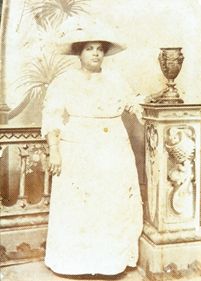Augusta Curiel
Augusta Curiel | |
|---|---|
 | |
| Born | 14 December 1873 |
| Died | 22 November 1937 |
| Nationality | Suriname |
Augusta Cornelia Paulina Curiel (1873 – 1937) was a Surinamese photographer. She and her sister created an important record of life in the early twentieth century.
Life
Augusta was born in Paramaribo in 1873. She took her mother's surname as her father abandoned them.[1]
Together with her sister Anna they were known as the ladies Curiel or the Curiel sisters. Augusta took pictures and Anna acted as her assistant. In 1929 Queen Wilhelmina granted her the title of hofleverancier.[2] She was the first photographer of Suriname for the royal house. The sisters Curiel were the owner of one of the most famous photo studios in Suriname: Augusta Curiel.
The sisters Curiel took years taking images of everyday life in Suriname. The photographs show that Augusta Curiel was a compositional and a technically gifted photographer. She always worked with available light and no light meter. Despite these limitations, they proved able to create beautiful images in dim government buildings, churches and factories. Curiel's oeuvre is made up of mostly daily life topics, which were of value to historians and other interested parties. They photographed both in their studio and on plantations and in the interior. The botanist Gerold Stahel took the women on some of his expeditions. Many of the surviving images are group portraits, made by and for (mission) schools, boarding schools and orphanages.
They used a heavy wood and plate camera. After the shooting, the negatives were developed and printed by illuminating off the glass from below. A few times a week, a batch of ice was delivered to the dark room, the required chemical baths to keep the proper temperature. Probably Anna and Augusta reused a lot of the expensive glass negatives. Fortunately, many cityscapes, landscapes, shots of factories, schools and orphanages have survived. Anna tried to continue the photo studio after the death of Augusta, but she sold the shop in the 1950s.
The glass was expensive and may have been reused several times to take different pictures. In 2005 Janneke van Dijk rediscovered many of Curiel's photographs. Her plates had remained for decades undisturbed in her local museum in Fort Zeelandia. Despite the time and the climate the pictures were in good condition.[1] They were digitised and published in 2007 as "Augusta Curiel, Photographer in Suriname from 1904 to 1937".[3]
-
Girls' sleeping quarters of the melaatsen stichting Sint Gerardus Majella
-
Sugar factory at plantation Mariënburg
-
Cabinboat with rowers
-
Sorting oranges in the Cultuurtuin
-
Market in Lelydorp at railway stop Landsspoorweg
-
View of Paramaribo
-
Plantation Alliance
References
- ^ a b djr (2016-10-11). "Digitaal Vrouwenlexicon van Nederland". resources.huygens.knaw.nl (in Dutch). Retrieved 2016-12-18.
- ^ Saskia Asser (2007). A critical history of photography in the Netherlands: Dutch eyes. Waanders. p. 329.
- ^ Janneke van Dijk; Hanna van Petten-van Charante; Laddy van Putten (2007). Augusta Curiel: fotografe in Suriname 1904-1937. KIT Publishers. ISBN 978-90-6832-481-5.
Further reading
- Dijk van, J., Petten van-van Charante, H. en Putten van, L. (2007) Augusta Curiel, Fotografe in Suriname 1904-1937 KIT Publishers ISBN 9789068324815
- Heer de, M. (2008), Fotografe van Suriname, Trouw, 24 januari







